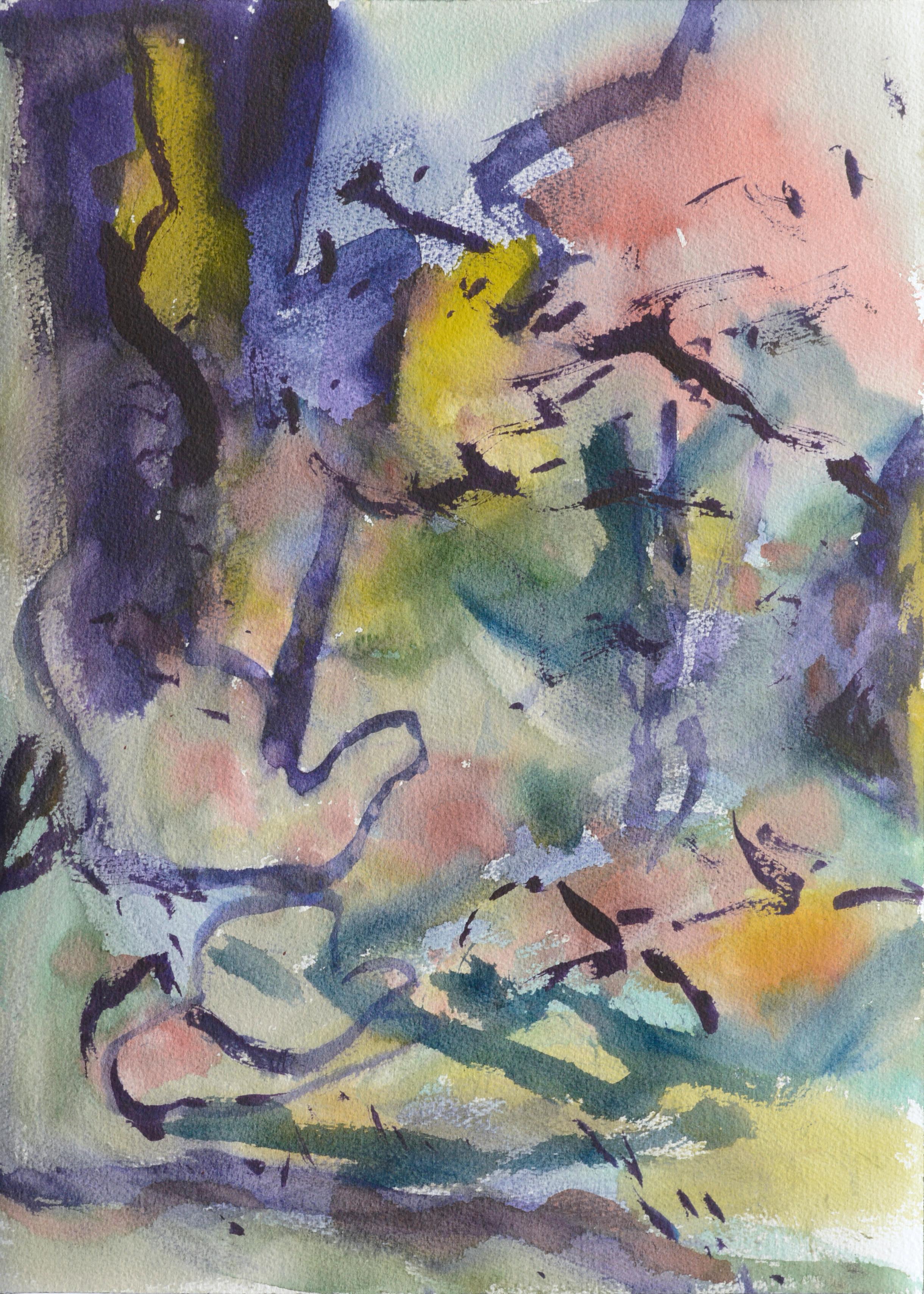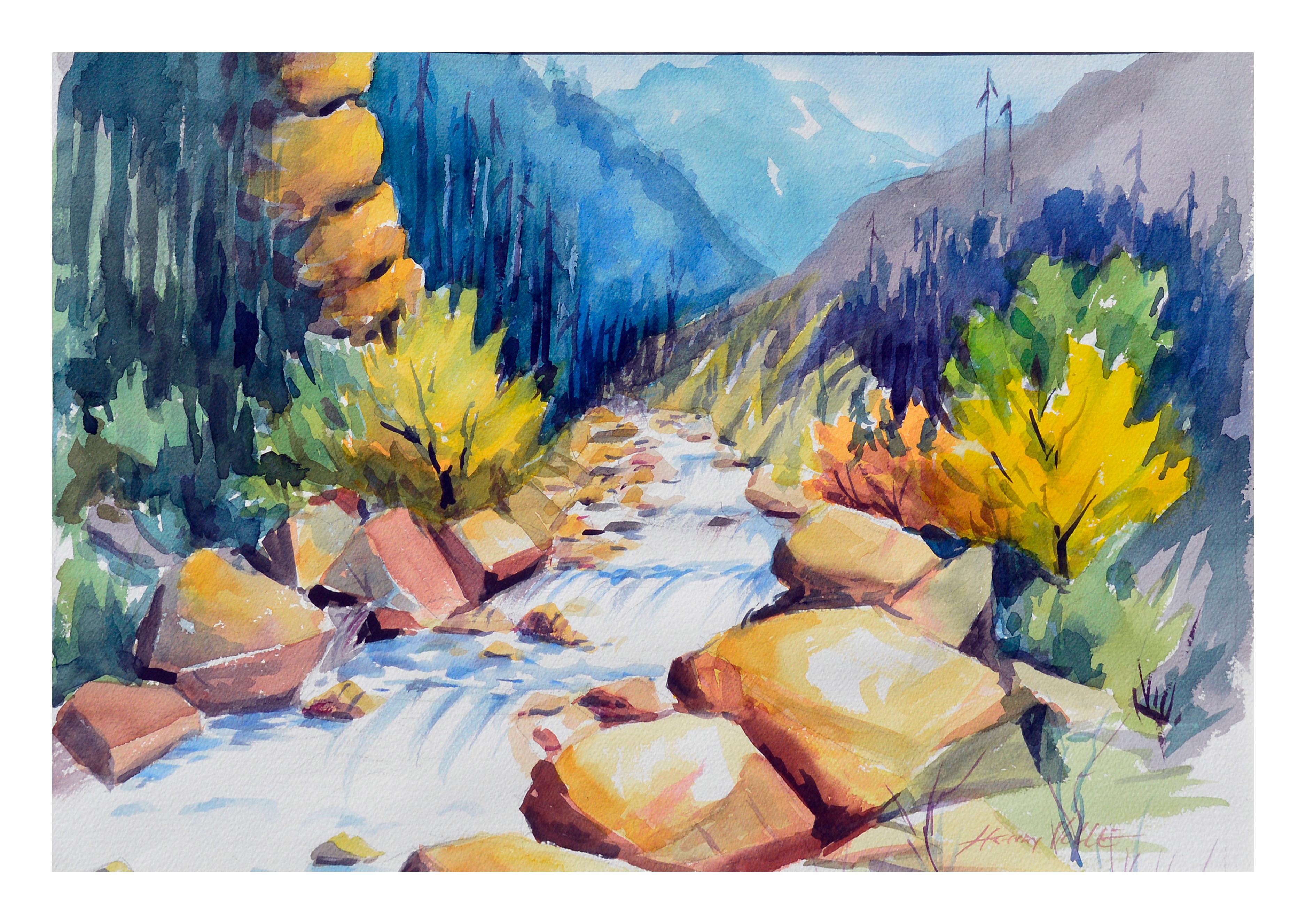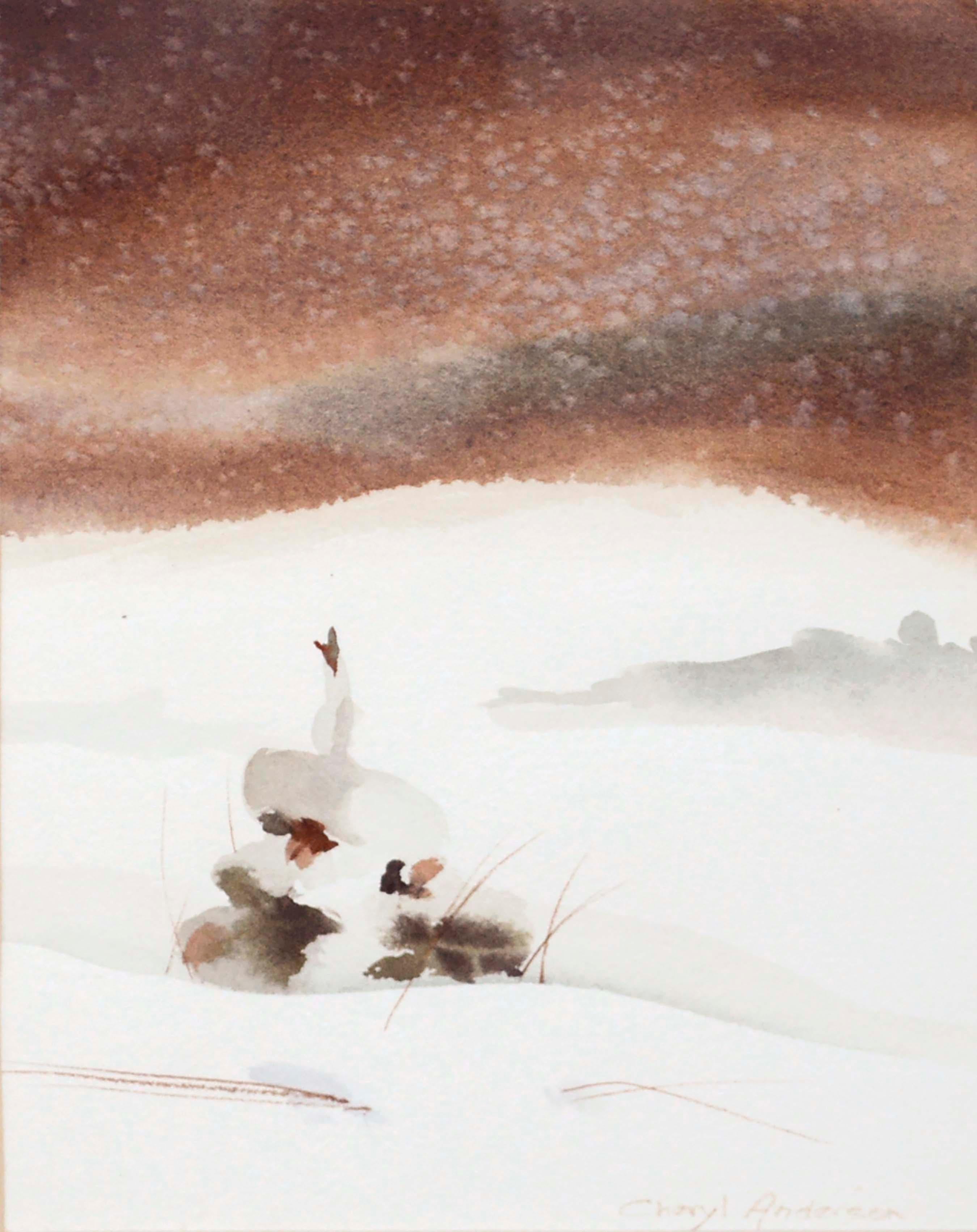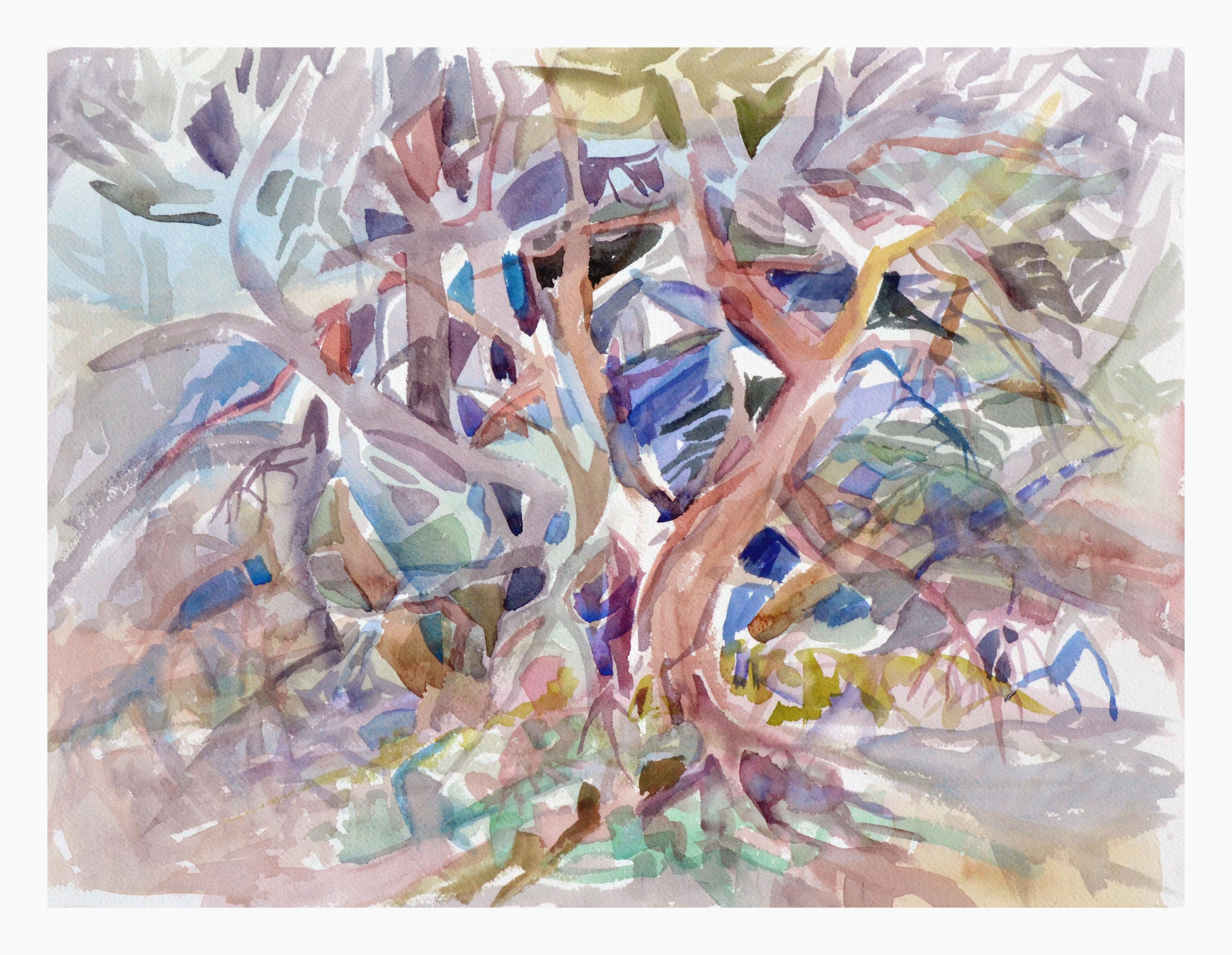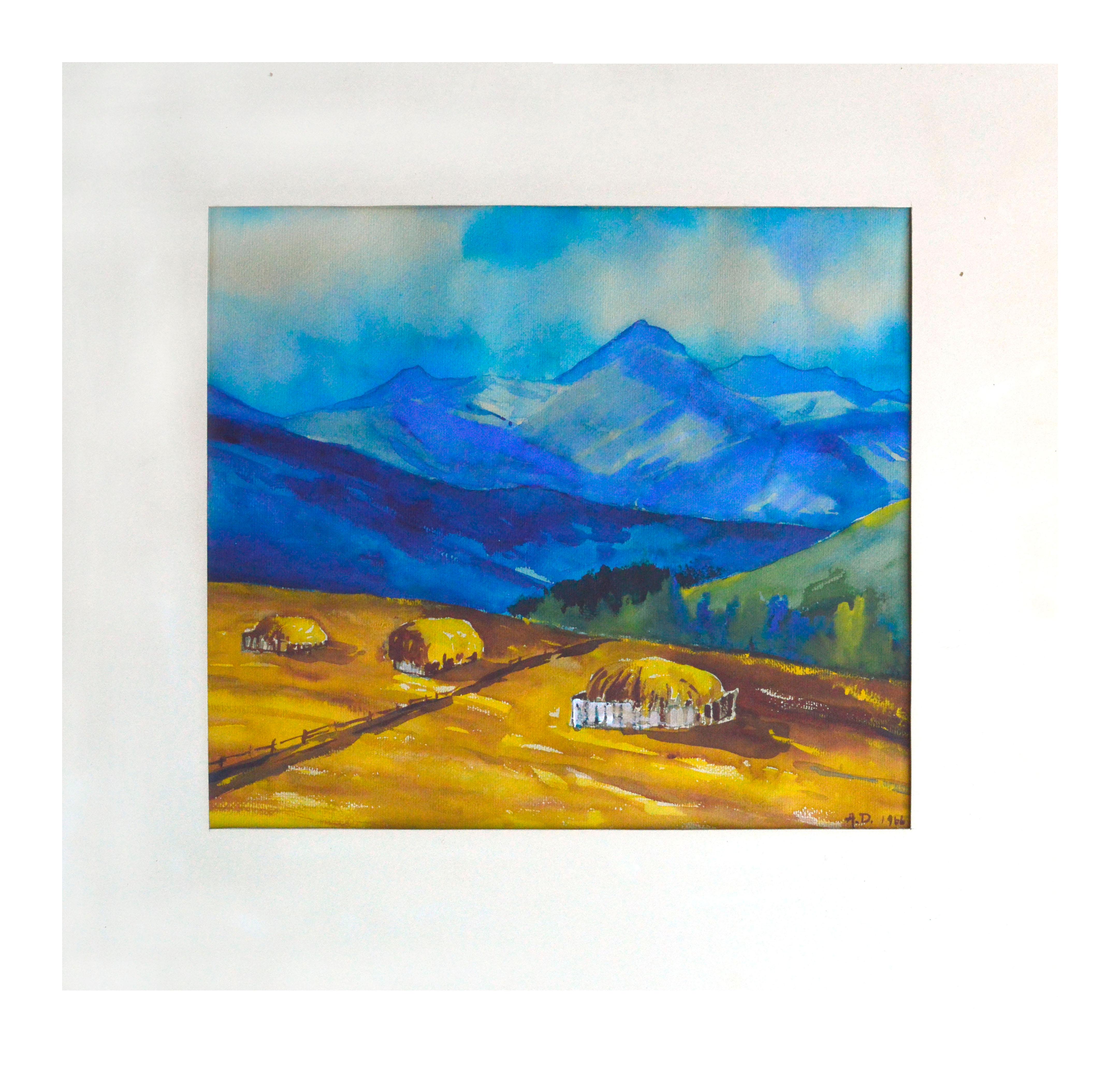Items Similar to "Monument Valley Arizona" - Desert Landscape
Want more images or videos?
Request additional images or videos from the seller
1 of 13
Albert DeRome"Monument Valley Arizona" - Desert Landscape1953
1953
About the Item
Detailed watercolor of Monument Valley by Albert DeRome (American, 1885-1959). The viewer is looking out over the valley from a high vantage point, with towering mesas in the distance. In the foreground, there are some shrubs and a small tree to the right side of the composition. DeRome has created a sense of vast distance by rendering the far background with a hazy quality while keeping the foreground in clear focus.
Signed "Albert DeRome" in the lower right corner.
Inscription on verso as a gift to the artist's mother.
Purchased from the estate of the artist Patterson's Antiques, Los Gatos.
Presented in a wood frame with a new white mat.
Image size: 5.75"H x 8"W
Frame size: 11"H x 14"W
Born in Cayucos, California, Albert De Rome (American, 1885-1959) became a California landscape painter, especially of natural landscapes formations, seascapes and marine scenes near Carmel and Monterey. Usually his palette was bright in both oil and watercolor, but he did the occasional nocturne. Scholars have compared his painting style and subjects to those of Thomas Hill and Albert Bierstadt. However, Albert De Rome never affiliated with any formal group of painters, although he had many close friends including Percy Gray, Gunnar Widforss and Will Sparks.
As a young man, Thomas De Rome worked at the Congress Spring Hotel in Saratoga, and in San Francisco at the Globe Foundry, owned by an uncle. He studied art under Arthur Mathews, John Stanton and Lorenzo Latimer at the Mark Hopkins Institute in San Francisco. Early in his career, he became known for political cartoons for the San Jose Mercury News. This job was followed by work in an advertising firm, J. Chas. Green Company, for whom he created billboards, signs and posters. During this time he began painting small oil and watercolor landscapes at the Oakland Estuary.
He sketched landscapes with William Keith, Percy Gray, Frank Moore, and Gunnar Widforss, and from 1915 to 1931, made many painting expeditions to Nevada, Arizona and throughout California. During that time he was also representing as a traveling sales manager George Haas and Sons, a candy company that had been one of his commercial art clients.
A serious head-on-collision in 1931 during one of those trips ended his professional career. He was hospitalized for eight months, and it took years for him to fully recuperate. Although he recovered his ability to paint, his agreement with his insurance company prevented him from selling his paintings. So he gave away one painting a month for thirty years. He also won many "amateur" awards for his impressionist, luminous landscapes, coastals and seascapes including six first prizes at the Monterey County Fair between 1939 and 1947.
Meanwhile, he moved to Pacific Grove with his wife and their teen-age son, and he did much painting at Point Lobos Reserve and other places around Monterey Bay. He turned mostly to oils because his arms did not have the reflexes for watercolors, and gradually as his left arm got stronger, he painted larger and larger paintings. He had the habit of recording on the backs of his paintings the names of the people who commented positively about the work, and many of his paintings had long lists.
He died in Carmel on July 31, 1959.
- Creator:Albert DeRome (1885 - 1959, American)
- Creation Year:1953
- Dimensions:Height: 11 in (27.94 cm)Width: 14 in (35.56 cm)Depth: 0.75 in (1.91 cm)
- Medium:
- Movement & Style:
- Period:
- Condition:Frame has some losses of paint (minimized, but included "as-is"). Some tonal ageing to paper, as expected.
- Gallery Location:Soquel, CA
- Reference Number:
About the Seller
4.9
Platinum Seller
These expertly vetted sellers are 1stDibs' most experienced sellers and are rated highest by our customers.
Established in 1986
1stDibs seller since 2014
2,541 sales on 1stDibs
Typical response time: <1 hour
- ShippingRetrieving quote...Ships From: Soquel, CA
- Return PolicyA return for this item may be initiated within 14 days of delivery.
More From This SellerView All
- Stream in Autumn - LandscapeBy StowLocated in Soquel, CASerene watercolor of a stream by an unknown artist named Stow (20th century). Signed "Stow" in the lower right corner. We sourced a group of watercolors by Stow from the Southwest Fl...Category
1980s American Impressionist Landscape Drawings and Watercolors
MaterialsPaper, Watercolor
- Vertical Purple AbstractBy Les AndersonLocated in Soquel, CAAbstract composition by Les Anderson (American, 1928-2009). Unsigned, but was acquired from the estate of Les Anderson in Monterey, California. No frame. Les (Leslie Luverne) Anders...Category
1980s American Impressionist Landscape Drawings and Watercolors
MaterialsPaper, Watercolor
- Mountain River Watercolor LandscapeBy Henry Hank VolleLocated in Soquel, CAColorful mountain river watercolor painting by Henry "Hank" Volle (American, 20th Century). Signed "Henry Volle" lower right. Artists bio on verso. Pre...Category
1970s American Impressionist Landscape Drawings and Watercolors
MaterialsPaper, Watercolor
- Snowy Pine - Minimal Winter LandscapeLocated in Soquel, CAMinimal winter landscape bordering on abstraction in earthy neutral tones of a pine tree in the snow, which the artist depicts using negative space, under a dark winter sky by Cheryl...Category
Late 20th Century American Impressionist Landscape Drawings and Watercolors
MaterialsPaper, Watercolor
- Vintage Abstracted Forest LandscapeBy Virginia J HughinsLocated in Soquel, CAGorgeous abstracted forest by Aptos, California artist Virginia J. Hughins (American, 1923-2004), circa 1970. Unsigned and unframed. Image size, 16"H x 20"L. Hughins was an accompli...Category
1970s American Impressionist Landscape Drawings and Watercolors
MaterialsPaper, Watercolor
- Mid Century Landscape -- Blue MountainLocated in Soquel, CAVivid mid century watercolor landscape of piercing blue mountains overshadowing a golden valley by an unknown artist. Signed "A.D. 1966" lower right. Pre...Category
1960s American Impressionist Landscape Drawings and Watercolors
MaterialsPaper, Watercolor
You May Also Like
- "Cloudy Dock Scene", working peir with fishermen, boats, and architectureBy John Cuthbert HareLocated in Rockport, MAJohn Cuthbert Hare was an accomplished New England painter born in Brooklyn, New York. He began his artistic journey by studying commercial art at the Pratt Institute in New York Cit...Category
Mid-20th Century American Impressionist Landscape Drawings and Watercolors
MaterialsPaper, Watercolor
- Mount MonadnockBy Gifford BealLocated in Milford, NHA fine monochromatic watercolor landscape painting of Mount Monadnock in New Hampshire by American artist Gifford Beal (1879-1956). Beal was born in New York City and studied for man...Category
Mid-20th Century American Impressionist Landscape Drawings and Watercolors
MaterialsPaper, Watercolor
- Mother and Children watercolor painting by John E. CostiganBy John CostiganLocated in Hudson, NYPainting measures 22" x 28" and framed 26" x 32" x 2" Hand-signed "J.E. Costigan NA 1952" lower left. About this artist: John Costigan was a self-taught painter distinguished by h...Category
Mid-20th Century American Impressionist Figurative Drawings and Watercolors
MaterialsPaper, Watercolor
- Poplars, a watercolor by Allen TuckerBy Allen TuckerLocated in Hudson, NYThis 1930 watercolor by American artist and architect Allen Tucker is framed with museum quality, non-reflective glass and archival matting. It was gifted by the artist to his friend...Category
1930s American Impressionist Landscape Drawings and Watercolors
MaterialsPaper, Watercolor
- The Rapids (Maine)By John WhorfLocated in Provincetown, MAJohn Whorf, born in 1903, was a talented, opinionated artist who achieved great success at a young age. Encouraged by his artistic father, Whorf studied briefly during his early te...Category
Early 20th Century American Impressionist Landscape Drawings and Waterco...
MaterialsPaper, Watercolor
- "Train Station, " Max Kuehne, Industrial City Scene, American ImpressionismBy Max KuehneLocated in New York, NYMax Kuehne (1880 - 1968) Train Station, circa 1910 Watercolor on paper 8 1/4 x 10 1/4 inches Signed lower right Provenance: Private Collection, Illinois Max Kuehne was born in Halle, Germany on November 7, 1880. During his adolescence the family immigrated to America and settled in Flushing, New York. As a young man, Max was active in rowing events, bicycle racing, swimming and sailing. After experimenting with various occupations, Kuehne decided to study art, which led him to William Merritt Chase's famous school in New York; he was trained by Chase himself, then by Kenneth Hayes Miller. Chase was at the peak of his career, and his portraits were especially in demand. Kuehne would have profited from Chase's invaluable lessons in technique, as well as his inspirational personality. Miller, only four years older than Kuehne, was another of the many artists to benefit from Chase's teachings. Even though Miller still would have been under the spell of Chase upon Kuehne's arrival, he was already experimenting with an aestheticism that went beyond Chase's realism and virtuosity of the brush. Later Miller developed a style dependent upon volumetric figures that recall Italian Renaissance prototypes. Kuehne moved from Miller to Robert Henri in 1909. Rockwell Kent, who also studied under Chase, Miller, and Henri, expressed what he felt were their respective contributions: "As Chase had taught us to use our eyes, and Henri to enlist our hearts, Miller called on us to use our heads." (Rockwell Kent, It's Me O Lord: The Autobiography of Rockwell Kent. New York: Dodd, Mead and Co., 1955, p. 83). Henri prompted Kuehne to search out the unvarnished realities of urban living; a notable portion of Henri's stylistic formula was incorporated into his work. Having received such a thorough foundation in art, Kuehne spent a year in Europe's major art museums to study techniques of the old masters. His son Richard named Ernest Lawson as one of Max Kuehne's European traveling companions. In 1911 Kuehne moved to New York where he maintained a studio and painted everyday scenes around him, using the rather Manet-like, dark palette of Henri. A trip to Gloucester during the following summer engendered a brighter palette. In the words of Gallatin (1924, p. 60), during that summer Kuehne "executed some of his most successful pictures, paintings full of sunlight . . . revealing the fact that he was becoming a colorist of considerable distinction." Kuehne was away in England the year of the Armory Show (1913), where he worked on powerful, painterly seascapes on the rocky shores of Cornwall. Possibly inspired by Henri - who had discovered Madrid in 1900 then took classes there in 1906, 1908 and 1912 - Kuehne visited Spain in 1914; in all, he would spend three years there, maintaining a studio in Granada. He developed his own impressionism and a greater simplicity while in Spain, under the influence of the brilliant Mediterranean light. George Bellows convinced Kuehne to spend the summer of 1919 in Rockport, Maine (near Camden). The influence of Bellows was more than casual; he would have intensified Kuehne's commitment to paint life "in the raw" around him. After another brief trip to Spain in 1920, Kuehne went to the other Rockport (Cape Ann, Massachusetts) where he was accepted as a member of the vigorous art colony, spearheaded by Aldro T. Hibbard. Rockport's picturesque ambiance fulfilled the needs of an artist-sailor: as a writer in the Gloucester Daily Times explained, "Max Kuehne came to Rockport to paint, but he stayed to sail." The 1920s was a boom decade for Cape Ann, as it was for the rest of the nation. Kuehne's studio in Rockport was formerly occupied by Jonas Lie. Kuehne spent the summer of 1923 in Paris, where in July, André Breton started a brawl as the curtain went up on a play by his rival Tristan Tzara; the event signified the demise of the Dada movement. Kuehne could not relate to this avant-garde art but was apparently influenced by more traditional painters — the Fauves, Nabis, and painters such as Bonnard. Gallatin perceived a looser handling and more brilliant color in the pictures Kuehne brought back to the States in the fall. In 1926, Kuehne won the First Honorable Mention at the Carnegie Institute, and he re-exhibited there, for example, in 1937 (Before the Wind). Besides painting, Kuehne did sculpture, decorative screens, and furniture work with carved and gilded molding. In addition, he designed and carved his own frames, and John Taylor Adams encouraged Kuehne to execute etchings. Through his talents in all these media he was able to survive the Depression, and during the 1940s and 1950s these activities almost eclipsed his easel painting. In later years, Kuehne's landscapes and still-lifes show the influence of Cézanne and Bonnard, and his style changed radically. Max Kuehne died in 1968. He exhibited his work at the National Academy of Design, the Art Institute of Chicago, the Carnegie Institute in Pittsburgh, the Memorial Art Gallery of the University of Rochester, and in various New York City galleries. Kuehne's works are in the following public collections: the Detroit Institute of Arts (Marine Headland), the Whitney Museum (Diamond Hill...Category
1910s American Impressionist Landscape Drawings and Watercolors
MaterialsPaper, Watercolor
Recently Viewed
View AllMore Ways To Browse
Desert Landscapes
Large Landscape Drawing
Arizona Artists
Arizona Painting
Paintings Of Arizona
Desert Vintage
Luminous Landscape
Arizona Landscape Art
Arizona Sign
Arizona Artists Landscape
Desert Scene
California Desert Painting
Arizona Landscape Painting
Arizona Vintage
Arizona Oil
Vintage Arizona Art
Desert Drawings
Albert Green

